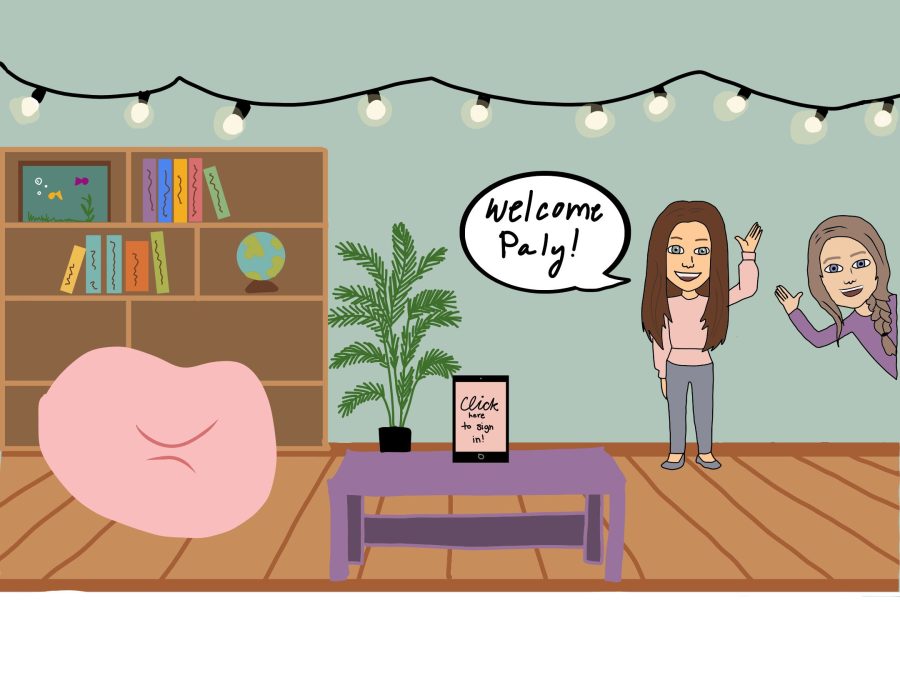Plants, flowers and welcoming art frame the light-blue walls of the Paly Wellness Calming Room, instilling a sense of serenity and calmness.
Despite the challenges of online school, the Wellness Center staff has implemented changes to their counseling and drop-in system and is providing resources to help students and staff during quarantine. These include the new Paly Wellness Calming Room, a virtual space for students to go whenever they need a break.
Mental Health and Wellness Coordinator Elizabeth Spector said virtual counseling sessions are being held via Telehealth, Zoom or a phone call, and the process for talking to a counselor remains essentially the same as in past years.
“Referrals in the past have typically come to us a number of ways, and that continues to be true,” Spector said. “It’s school counselors who refer (students) to school psychologists. Parents can refer others. Support staff at the school can refer. Teachers can refer. Students can also refer themselves, so we get referrals a number of different ways. Except, obviously, you can’t walk into the physical space.” Students can also directly be referred to therapists in the wellness center according to Aquino.
Spector also said the Wellness Center has changed its procedure for referrals, since that cannot be done in-person either.
“We have our virtual support request form, (which) is a Google form that students fill out that comes to the Wellness Center, and then we assign it to one of our therapists.” Spector said. “That person will check in with the person who’s requested the appointment. We also have our Zoom drop-in hours and our virtual Wellness Centers which are both full of clickable links. (Students can) always email anyone on the Wellness team or their school counselor to get connected to us or school.”
Wellness Outreach Worker Whitney Aquino said while drop-in hours are an open-space, they remain confidential; students are directed to a breakout room with either a counselor or Spector and can have a one-on-one, private conversation.
To inform students about the resources available, the Wellness team is organizing a Wellness Center Week much like the on-campus Wellness Fair they held last year.
“We had such a great time with the Wellness Fair last year,” Aquino said. “We had over 200 students that came through and almost 20 different clubs and organizations. Trying to take that and put it virtual was a little bit difficult, but I’m glad that Gunn and Paly Wellness are collaborating on this to have different guest speakers during lunch and raffle prizes for the students who do attend.”
Aquino said the Wellness Fair will also provide resources for students about all aspects of wellness.
“We have all different kinds of wellness organizations — everything from mental health to physical health wellness,” she said. “The goal of it is for students to be able to learn more about what are the resources available out there in our community.”
Because of the pandemic, Spector said feelings of stress and anxiety are particularly common themes among many students this year and that the Wellness Center is ready to help.
“There’s a lot on people’s plates,” Spector said. “I think the national data reflects an increase in anxiety and depression. There’s a lot of grief for people who have lost loved ones to COVID-19. There’s a lot of unknowns. When is this going to end? What will life post COVID-19 look like? I think the world, especially America, is really grappling with all of that.”
Spector said despite the overwhelming changese, physical and mental health should still be a priority for students, and she advises people take breaks throughout the school day.
“On parent nights, we’ve been sharing with parents: 25 minutes on. Five minutes off,” Spector said. “So if you can work in 30 minute increments, those five minutes should be moving breaks. Getting up, stretching, doing some yoga poses, lifting a couple of weights — whatever it is that gets you moving.”
Outside of the Paly Wellness Center, licensed clinical social worker Mary Ellen Lemiuex from Menlo Park said that counseling poses a general challenge for all mental health workers in a virtual setting but said it can still be beneficial for students or faculty who need the help.
“Almost all therapy is done by videoconferencing now, although some therapists are meeting with clients outdoors or with masks and social distancing,” Lemieux said. “The good news is that therapy is more accessible than ever. No fighting traffic or rushing from one place to another. The bad news is that therapy on a screen is different. Emotions are harder to read, and it’s harder to feel an emotional connection between the client and therapist. ”
According to Lemieux, the number of clients she is currently seeing has remained the same as before the start of the pandemic.
“At first, clients tried to wait (it) out until we could do in-person therapy, but then agreed to try video,” Lemieux said. “I see a lot of people in their cars. I think we all look forward to meeting in person again, but some virtual work will always remain.”
Lemieux said therapy may feel repetitive right now, since not much new is happening and it may be difficult to find things to talk about as a result.“Some ways to make things more interesting in therapy is give your therapist a tour of your house or your room or your closet, introduce your pet, listen to favor music or podcasts together, show them favorite family photos,” Lemieux said. “It’s amazing how talking about ordinary things can open doors to talk about the emotional things that really matter.”

